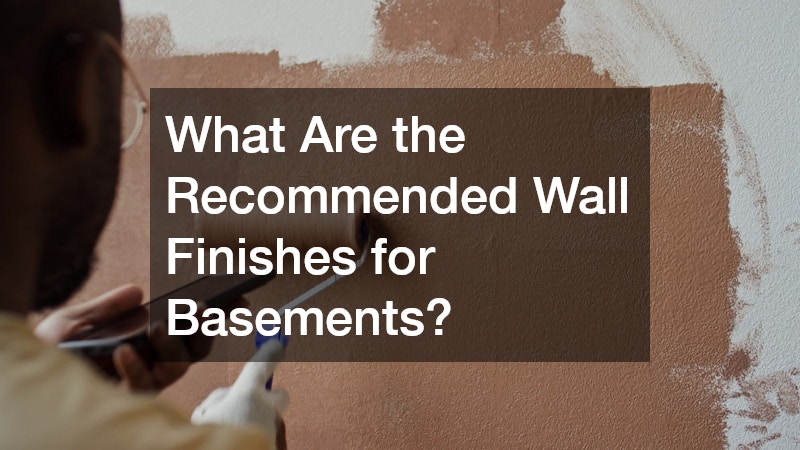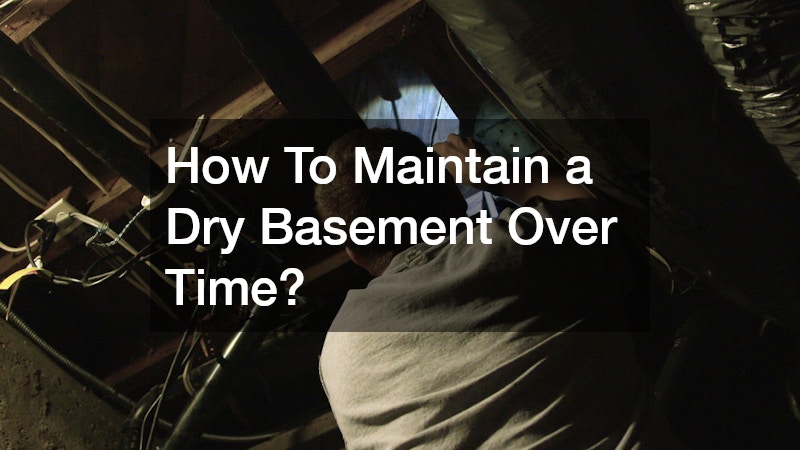Creating a dry, durable basement space is one of the most rewarding investments a homeowner can make. Not only does it add usable square footage, but it also protects your home from long-term structural issues. According to basement remodeling experts, the secret to a successful renovation lies in understanding how water behaves, how air circulates, and how materials respond to changing temperatures and humidity.
Basements are naturally prone to dampness because they sit below ground level, where soil retains moisture and plumbing lines often run through walls or ceilings. Over time, small leaks or poor drainage can turn into significant damage if not properly addressed. That’s why professional basement remodeling experts often work closely with plumbers, home builders, and mold remediation service providers to create a coordinated approach.
Whether you’re finishing a new space or restoring an older one, this guide explores what basement remodeling experts recommend for keeping your lower level dry, comfortable, and structurally sound. From back flow prevention to local floor restoration, we’ll cover the interconnected steps that lead to a basement designed to last for decades.
What Are the Common Causes of Basement Moisture?
Factors Contributing to Excess Humidity
Basement remodeling experts often begin any project by addressing humidity. Excess humidity in a basement can lead to mold, mildew, and air quality problems that spread throughout the home. The issue frequently starts with small leaks in residential plumbing or inadequate ventilation. Even when the walls look dry, the surrounding soil might be pushing moisture inward, creating hidden damp spots.
Plumbers play a critical role in assessing these sources. They inspect pipes, drainage lines, and back flow prevention systems to ensure there’s no seepage or pressure buildup. Poor air circulation only makes matters worse, trapping moist air and encouraging condensation on cool surfaces. Home builders who specialize in basement construction often recommend adding vapor barriers and improving insulation to maintain balance between temperature and moisture.
Drainage Issues and Their Solutions
Even with quality waterproofing, poor drainage around the foundation can cause recurring basement moisture. Basement remodeling experts often start by examining the grade of the land around the home. If the soil slopes toward the foundation, water naturally collects there. Over time, this can compromise basement construction materials and allow seepage through cracks.
Solutions usually begin with redirecting surface water away from the house using proper grading, gutters, and downspout extensions. In more severe cases, installing a French drain or sump pump system ensures excess water is safely diverted. Plumbers help integrate these systems with existing residential plumbing networks, while home builders make sure the installation complements the structure’s integrity.
How Can I Effectively Waterproof My Basement?
Interior vs. Exterior Waterproofing Methods
Waterproofing is one of the most critical steps basement remodeling experts take before construction begins. The right method depends on whether moisture is seeping through from the outside or forming due to condensation inside.
Exterior waterproofing involves sealing the outer walls with membranes or coatings that prevent water from penetrating. It’s a major project that may require excavation, making it more suitable for new basement construction or when extensive repairs are already needed. Home builders often coordinate with plumbers to ensure the drainage systems and waterproof barriers work in harmony.
Interior waterproofing focuses on controlling moisture that’s already inside. This can include applying sealants to interior walls, installing vapor barriers, or setting up dehumidifiers. Basement remodeling experts often recommend a combination of both approaches for the best long-term results.
Choosing the Right Materials for Waterproofing
The materials used in waterproofing can make or break the success of a basement project. Choosing wrong means you might need to look into a mold remediation service later. Basement remodeling experts typically rely on flexible coatings and membranes that can move slightly with the foundation as it expands or contracts. Rigid materials may crack over time, creating entry points for water.
Epoxy and polyurethane sealants are popular for interior applications, while rubberized asphalt membranes are favored for exterior surfaces. During basement construction, home builders may apply these materials in multiple layers for added protection. Choosing materials rated for below-grade use is critical; products intended for above-ground walls often fail when exposed to constant ground moisture.
What Are the Best Ventilation Options for Basements?

Natural Ventilation Strategies
Proper ventilation is vital for a basement’s longevity. Basement remodeling experts often say that no matter how dry the space looks, poor airflow will eventually lead to musty smells or microbial growth. When possible, incorporating windows or vents allows fresh air to circulate naturally, balancing humidity levels and improving indoor air quality.
Natural ventilation also helps regulate temperature changes that occur as warm, moist air rises and cooler air settles below ground. Home builders frequently integrate window wells or light wells during basement construction to maximize airflow and light exposure. These features not only enhance ventilation but also make the space feel more open and livable.
Mechanical Ventilation Systems
When natural airflow isn’t enough, mechanical systems come into play. Basement remodeling experts often suggest using exhaust fans, air exchangers, or dehumidifiers to maintain a consistent environment. Mechanical systems can be especially effective in homes with limited windows or tight layouts.
A whole-house ventilation system that includes the basement is often the best approach for larger properties. These systems work with the existing HVAC setup to continuously replace stale, humid air with fresh outdoor air. It’s important to coordinate installation with plumbers and home builders, as ductwork or vent paths must avoid interfering with plumbing lines or load-bearing structures.
How Do I Manage Basement Humidity Levels?
Using Dehumidifiers Effectively
Dehumidifiers are one of the simplest tools basement remodeling experts recommend for maintaining air balance. They pull moisture out of the air and collect it in a reservoir or drain it automatically into a plumbing line. Placement matters—dehumidifiers should be positioned away from walls and furniture for maximum air circulation.
Basement remodeling experts typically suggest running a dehumidifier continuously during humid months and checking the water output regularly. Some models allow integration with residential plumbing, so excess water drains directly without manual emptying. Plumbers can install these connections securely to prevent leaks or back flow issues.
Monitoring Humidity With Moisture Meters
Maintaining a dry basement means staying proactive. Basement remodeling experts frequently use moisture meters to detect hidden dampness in walls, floors, and insulation. These devices help track patterns of humidity, making it easier to identify problem areas before visible damage occurs.
Moisture readings are particularly useful after emergency plumbing repairs or heavy rainstorms. If humidity levels spike, it may signal a leak or seepage somewhere in the system. Home builders and plumbers can then collaborate to identify and correct the source.
What Flooring Options Are Suitable for Basements?

Best Moisture-Resistant Flooring Materials
Flooring is one of the most visible features of a finished basement, and it plays a huge role in durability. Basement remodeling experts often stress that not all flooring materials are suited for below-grade conditions. Options like solid hardwood or carpet tend to trap moisture and deteriorate quickly. Instead, materials like vinyl plank, ceramic tile, or sealed concrete hold up much better.
Vinyl is especially popular because it resists water and can mimic natural textures like wood or stone. Tile flooring offers an elegant, long-lasting surface, though it requires careful installation to prevent moisture from seeping through grout lines. Local floor restoration specialists often work alongside basement remodeling experts to repair or refinish concrete slabs before new flooring is installed. A smooth, sealed foundation minimizes vapor transfer and provides a solid base for any finish material.
Installation Considerations for Basement Flooring
Proper installation is just as important as material choice. Basement remodeling experts often advise homeowners to test the concrete slab for moisture before installation begins. If vapor emissions are too high, it can undermine adhesives and cause flooring to buckle or lift.
Some basement construction projects include radiant floor heating systems, which help regulate temperature and reduce condensation. In such cases, coordination with plumbers is essential to ensure proper connections to the home’s residential plumbing network. Heat and moisture must be balanced carefully to avoid damaging materials over time.
How Can I Insulate My Basement Effectively?
Types of Insulation Suitable for Basements
Insulation is one of those details basement remodeling experts never overlook, because it determines how comfortable and energy-efficient the finished space will be. A poorly insulated basement can cause temperature swings, condensation, and even structural strain. The most common insulation types include spray foam, fiberglass batts, and rigid foam boards, each offering unique benefits depending on your basement’s design.
Spray foam is often the go-to option for tight corners and irregular wall shapes because it expands to fill gaps and creates a seamless air barrier. Fiberglass batts are cost-effective but must be installed with a vapor barrier to prevent trapping moisture behind walls. Rigid foam boards, meanwhile, resist water absorption and provide excellent thermal resistance, making them a favorite among home builders working on basement construction.
Common Mistakes in Basement Insulation
Even the best materials fail when installation is rushed or incorrect. One of the most common mistakes basement remodeling experts see is homeowners using standard above-grade insulation instead of moisture-resistant products. This can lead to damp insulation that sags, smells, and encourages microbial growth.
Another frequent issue arises when insulation is applied directly onto wet or unsealed concrete. Without a proper moisture barrier, water vapor seeps into the material and compromises its effectiveness. Home builders suggest sealing the foundation walls first using appropriate waterproof coatings. Only once surfaces are dry should insulation go up.
What Are the Recommended Wall Finishes for Basements?

Water-Resistant Wall Materials
Walls in a basement face constant pressure from the surrounding soil, which means they need to withstand both moisture and temperature fluctuations. Basement remodeling experts tend to favor materials like cement board, vinyl panels, or moisture-resistant drywall. These materials resist swelling and deterioration better than standard drywall, especially when paired with proper waterproofing.
Cement board, often used behind tile installations, is an excellent choice for bathrooms or laundry areas located in the basement. Vinyl wall systems, on the other hand, are easy to clean and maintain, providing a sleek, finished look that resists mold growth. During basement construction, home builders might also install vapor barriers behind these surfaces to block moisture infiltration.
Paints and Sealants to Consider
Paint isn’t just cosmetic—it can be a powerful line of defense. Basement remodeling experts often recommend elastomeric or epoxy-based paints designed to resist water penetration. These coatings expand and contract with the surface, helping to seal tiny cracks that develop over time.
Before painting, the walls should be thoroughly cleaned, dried, and primed with a moisture-blocking base coat. This step helps paint adhere properly and extend its lifespan. For older basements, applying a penetrating sealer first can strengthen porous concrete and prevent efflorescence—the white, powdery residue that forms when water evaporates through masonry.
What Lighting Solutions Work Best for Basements?
Maximizing Natural Light
Light transforms how a basement feels. Basement remodeling experts often start by exploring how to bring in as much natural light as possible. Window wells, egress windows, and light shafts allow sunlight to reach below-grade rooms safely and effectively. When combined with reflective finishes on walls and ceilings, even limited daylight can make a big difference.
Adding glass doors or partial partitions helps natural light flow deeper into the basement, reducing the need for artificial lighting during the day. Home builders frequently design basement construction around these elements, ensuring structural openings meet local codes while still promoting brightness.
Choosing Artificial Lighting
Even with sunlight, artificial lighting remains crucial for a basement’s ambiance. Basement remodeling experts recommend layering lighting—using a mix of overhead fixtures, task lighting, and accent lights—to create depth and warmth. LED recessed lights are popular for their efficiency and low heat output, especially in low-ceiling areas.
Track lighting or wall sconces can highlight architectural details, artwork, or furniture zones, giving the basement a finished, welcoming look. In utility areas, brighter task lighting helps with maintenance and safety. Home builders often pair these lighting plans with energy-efficient wiring layouts, ensuring that fixtures complement the room’s overall purpose.
How To Maintain a Dry Basement Over Time?

Regular Inspection and Maintenance Tips
Once the basement is complete, ongoing maintenance becomes the key to longevity. Basement remodeling experts recommend inspecting all critical systems—plumbing, drainage, waterproofing, and ventilation—at least twice a year. Look for signs of leaks, condensation, or discoloration on walls and floors.
Plumbers should test back flow prevention devices periodically to ensure they’re functioning correctly. After heavy rain or snowmelt, check sump pumps, downspouts, and exterior grading for blockages or damage. These simple habits prevent minor issues from turning into major repairs.
Upkeep of Waterproofing Systems
All waterproofing systems have a lifespan, and even the best materials eventually need renewal. Basement remodeling experts advise homeowners to reseal interior walls and floors every few years using moisture-resistant coatings. This avoids the need for black mold remediation down the line. Exterior membranes and drainage components may last longer but still require inspection after severe weather events.
If your home is part of an older development, coordinate with plumbers and home builders to verify that stormwater pollution control systems are still performing effectively. Sediment buildup or erosion can reduce drainage efficiency, forcing water toward your foundation. Addressing these issues promptly preserves the integrity of both the basement and the surrounding landscape.
Creating a dry, durable basement is less about one-time fixes and more about long-term systems that work together. Basement remodeling experts agree that success depends on understanding how each component—plumbing, flooring, insulation, ventilation, and drainage—interacts within the environment. When these systems complement one another, the basement becomes a true extension of the home rather than a constant maintenance concern.
